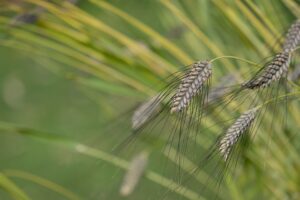Ancient grains, with their rich nutritional profile and environmental sustainability, offer a healthier and greener choice over refined grains. By incorporating these hearty crops into our diet, we not only nourish our bodies but also contribute to protecting our planet and add to being more self-sufficient.
History of Ancient Grains
Ancient grains, revered for their nutritional content and rustic taste, have been a staple in the human diet for thousands of years. These grains, untouched by modern science and breeding techniques, offer a bounty of health benefits, including high amounts of fiber, protein, and various essential nutrients. Often grown in small quantities and harvested the same way for millennia, ancient grains are a testament to our ancestors’ understanding of nutritious and sustainable farming. This chapter will delve into the remarkable history and diverse types of these grains that are making a resounding comeback in today’s health-conscious world.
Ancient Grains in Early Civilizations
Ancient grains formed the bedrock of nutrition in early civilizations around the globe. For instance, the Mayans relied heavily on amaranth, cultivating it for its high protein content and its ability to thrive in harsh weather conditions. In Egypt, emmer wheat was a staple of the pharaohs’ diet, and it was often used as currency due to its high value. Quinoa, revered as the “mother grain” by the Incas, was cultivated in the Andean region due to its hardiness and nutritional value. In ancient China, millet was the grain of choice before rice became prevalent. These grains, fundamental to the early civilizations, provided sustenance, shaped cultures, and even played a role in their religious and ceremonial life.
Evolution and Cultivation Over the Centuries
Over the centuries, the cultivation of ancient grains has seen numerous adaptations and changes. As civilizations grew, evolved, and interacted with each other, these grains were disseminated and cultivated in various parts of the world, each region adding its unique touch to their cultivation and use. Despite the advent of modern, genetically modified crops, these ancient grains have remained relatively unchanged due to their robust nature and adaptability to diverse climates. Farmers started to value the resilience of these crops, often choosing to grow them in tandem with modern varieties to safeguard against crop failure. The cultivation techniques also evolved, incorporating elements of both traditional wisdom and modern scientific knowledge to enhance yield and maintain the nutritional integrity of these grains. Today, they are cultivated globally, either as a primary crop or as a part of crop rotation systems, testifying to their timeless value and adaptability.
Use of Ancient Grains
In various civilizations, ancient grains held more than just nutritional value; they were integral to the cultural fabric, serving as pivotal elements in rituals, rites, and celebrations. In ancient Egypt, emmer wheat was prominent in the making of beer for religious ceremonies. In the Inca civilization, quinoa was deemed sacred and its first fruits were offered to the Sun God Inti. Millet in ancient China, aside from being a staple food, featured in their festivals such as the Autumn Harvest. Even today, these grains are steeped in tradition and customs, contributing to the rich tapestry of cultural diversity. Their cultural significance resonates across time, highlighting the timeless and profound connection between food, culture, and spirituality.
Ancient Grains in Traditional Cooking
Traditional cooking worldwide often showcases the unique flavors and textures of ancient grains. In Ethiopia, teff, a tiny, protein-rich grain, is used to make injera, a sourdough-risen flatbread with a slightly spongy texture. In Mexico, amaranth, once a staple grain for the Aztecs, is popped and mixed with honey or molasses to produce alegria, a popular sweet treat. The Middle Eastern dish tabbouleh uses bulgur wheat as a primary ingredient, providing a nutty flavor and chewy texture. In India, millets are used to prepare a variety of traditional dishes such as roti (flatbread), dosa (a type of pancake), and khichdi (a one-pot dish with vegetables and lentils). These examples illustrate the versatility of ancient grains in traditional cooking, lending themselves to a wide range of culinary expressions that serve both as comfort food and a link to cultural heritage.
Modern-Day Uses and Incorporation into Diverse Diets
In today’s world, the culinary applications of ancient grains have expanded far beyond traditional cooking. These grains have found their way into contemporary kitchens and restaurants, appearing in everything from breakfast cereals and salads to baked goods and pastas. A rise in gluten intolerance and a desire for healthier food choices have also driven the popularity of quinoa, amaranth, and millets. Moreover, their high fiber, protein content, and rich array of vitamins and minerals make them an excellent addition to vegetarian and vegan diets. Meanwhile, fitness enthusiasts favor these grains for their sustained energy release, aiding in workout recovery. Nutritionists and health-conscious individuals are rediscovering these ancient grains and incorporating them into diverse diets, paving the way for a resurgence of these nutritional powerhouses in the modern culinary scene.
Benefits of Ancient Grains
Ancient grains are renowned for their impressive nutritional profile. They are typically high in fiber, making them beneficial for digestive health and aiding in weight management by promoting a feeling of fullness. Many of these grains, like quinoa and amaranth, are complete proteins, meaning they contain all the essential amino acids our bodies need. They also provide a rich source of vitamins and minerals, including vitamin E, magnesium, iron, and zinc. Moreover, many ancient grains are gluten-free, making them a suitable choice for individuals with celiac disease or gluten sensitivity. These grains are also known to contribute to heart health, with studies showing that their regular consumption may reduce the risk of heart disease. Furthermore, their low glycemic index promotes steady blood sugar levels, making them a favorable option for individuals with diabetes. Their rich nutritional content and associated health benefits underscore the value of incorporating ancient grains into a balanced diet.
Dietary Advantages Over Refined Grains
Ancient grains hold a significant advantage over refined grains in terms of nutritional value. Unlike refined grains, which have been stripped of their bran and germ during processing, ancient grains are often consumed in their whole, unaltered state. This means they retain all of their natural nutrients, including fiber, proteins, vitamins, and minerals. Refined grains, on the other hand, lose much of these valuable nutrients during processing. As a result, foods made from refined grains often need to be ‘enriched’ with synthetic vitamins and minerals to counteract the nutritional loss, which still doesn’t measure up to the natural nutritional bounty found in ancient grains. Additionally, the intact fiber in ancient grains aids in digestion and helps maintain steady blood sugar levels, as opposed to refined grains that can lead to blood sugar spikes. Therefore, opting for ancient grains over refined ones can significantly enhance the nutritional quality of one’s diet.
Sustainability of Ancient Grains
Ancient grains also offer environmental benefits due to their inherently sustainable nature. These hardy crops can thrive in harsh conditions with minimal water and fertilizer inputs, making them more resilient to climate change than many modern varieties. Additionally, because many ancient grains are well-suited to organic farming practices, they contribute less to chemical pesticide and fertilizer run-off, thus reducing ecological impact. Furthermore, the diversity of ancient grains can contribute to crop rotation practices that enhance soil health and biodiversity. Therefore, choosing ancient grains not only nourishes our bodies, but also plays a part in protecting our planet.
Conclusion
In summary, ancient grains offer a multitude of health benefits that make them a valuable addition to any diet and add to living a more self-sufficient life. Their nutritional profile and sustainability make them an attractive alternative to refined grains. By incorporating these nutrient-dense and eco-friendly options into our meals, we can nourish our bodies and contribute towards a healthier planet.
References:
https://pubmed.ncbi.nlm.nih.gov/27687519/
https://pubmed.ncbi.nlm.nih.gov/29497244/
https://pubmed.ncbi.nlm.nih.gov/12690910/
https://pubmed.ncbi.nlm.nih.gov/27729921/
https://pubmed.ncbi.nlm.nih.gov/23299714/


